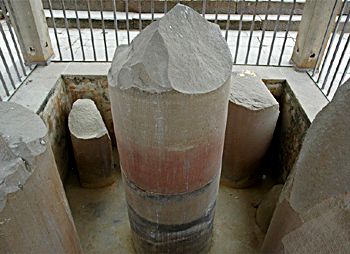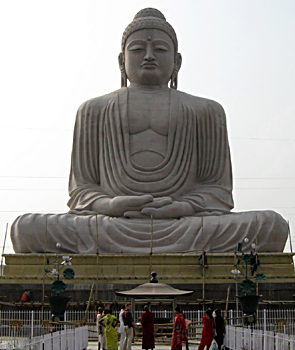 Early Buddhist art and architecture had been largely influenced by King Ashoka of Maurya Empire. He is known to have constructed several stupas which are sacred pile of bricks and had been erected in the memory of Lord Buddha. Free standing stone pillars is also an important feature of Ashoka`s architecture. The stone pillars designed by this great Emperor were generally monolithic columns and the greatest example of such pillars was in Sarnath.
Early Buddhist art and architecture had been largely influenced by King Ashoka of Maurya Empire. He is known to have constructed several stupas which are sacred pile of bricks and had been erected in the memory of Lord Buddha. Free standing stone pillars is also an important feature of Ashoka`s architecture. The stone pillars designed by this great Emperor were generally monolithic columns and the greatest example of such pillars was in Sarnath.
Ashoka`s erected pillars to promulgate his order and thus they had the obvious political purpose of asserting the centralized power of his monarchy. Ashoka saw Buddhism as a unifying force and as a result all his architectural features testified his belief. However, the syncretism at the heart of the Ashokan ideal is apparent in their embellishment with indigenous and imported symbols of royalty, with specifically Buddhist symbols and with symbols relating to India`s most ancient native tradition, centred on Indra`s great predecessor and rival Lord Varuna - the `Water Cosmology`. Some of the essential features of Ashoka`s architecture included Indra`s pole (yashti), the Axis Mundi (skambha) associated with Vedic and native shrines, the standard of kingship (dhvaja).
 Among the many pillars erected by Ashoka the remains are also in fragments and they represent some of the essential features. The pillars are surrounded by a vedika and pradakshina-patha but without visible bases, an inflated shaft rose directly from water-logged ground - presumably in accordance with yashti symbolism - to a tassel-like cap and an abacus surmounted by an animal device. In several cases, including the two complete ones, the animal is a lion which is an imported royal symbol. Surviving capitals with the indigenous bull or elephant are also known not to have been unique. The most magnificent examples, however, are those from Sanchi and Sarnath, both with four lions back-to-back, the latter ones surmounted by a Dharmachakra and standing on an abacus ringed with symbols of royalty - a bull, an elephant, a lion and a horse separated by chariot wheels. The abacus at Besarh is rectangular and unadorned but all the others are discs decorated with `Water Cosmology` symbols - in particular the hamsa and padma, the latter stylized along the lines of the Greek anthemion.
Among the many pillars erected by Ashoka the remains are also in fragments and they represent some of the essential features. The pillars are surrounded by a vedika and pradakshina-patha but without visible bases, an inflated shaft rose directly from water-logged ground - presumably in accordance with yashti symbolism - to a tassel-like cap and an abacus surmounted by an animal device. In several cases, including the two complete ones, the animal is a lion which is an imported royal symbol. Surviving capitals with the indigenous bull or elephant are also known not to have been unique. The most magnificent examples, however, are those from Sanchi and Sarnath, both with four lions back-to-back, the latter ones surmounted by a Dharmachakra and standing on an abacus ringed with symbols of royalty - a bull, an elephant, a lion and a horse separated by chariot wheels. The abacus at Besarh is rectangular and unadorned but all the others are discs decorated with `Water Cosmology` symbols - in particular the hamsa and padma, the latter stylized along the lines of the Greek anthemion.
The surviving remains are of sandstone, the exposed surfaces of which are usually polished. The conventional treatment of the tassel-like cap in all surviving examples reveals Persian influence and it seems unlikely that stone construction on the scale of these pillars could have been initiated in India without the experience imported by Persian immigrants.
The erection of `Pillars of the Law` was but part of Ashoka`s imperial building policy: complementing it was the foundation of stupas. The emperor is reputed to have been responsible for a vast number of such pillars throughout India to enshrine the relics of Lord Buddha disinterred from the original ten. These were the nucleii of monasteries which flourished only with Ashoka`s encouragement of a teaching brotherhood. The most important monasteries, of course, were at the sites of the major events in the Buddha`s career and they received other imperial endowments too. At Bodh Gaya, for instance, the Bodhi-ghara was built for the ritual libation of the bodhi tree, decreed by Ashoka, and the altar-like Vajrasana enshrined the Buddha`s seat beneath it.
The remains of a grand Buddhist shrine uncovered at Bairat, including fragments with Mauryan polish and inscriptions associated with Ashoka, suggest some similarity to the images of the Bodhi-ghara. A ring of at least twenty-seven octagonal wooden columns was later reinforced with brick piers and surrounded by a circular wall beyond a circumambulatory path. There was, presumably, a domical cover over the devotional object which was probably a stupa. The rectangular enclosure in it seems to have been a later addition.
It is true that Mauryan influence declined to a large extent after the reign of Ashoka but at the same time it can be said that his contributions in the spread of Buddhism had not declined including his notable contributions in the field of architecture. This is evident that even after Ashoka some of his architectural styles and designs have been followed in many of the Buddhist architectural features.



















